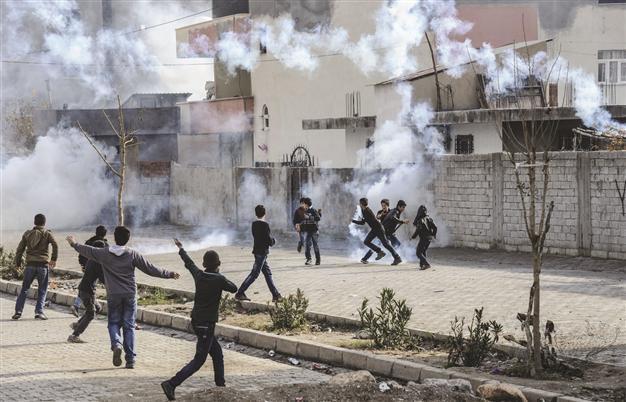10 questions to understand clashes in Turkey’s southeastern Cizre district
Gülden Aydın - ISTANBUL

AFP Photo
The Cizre district in the southeastern province of Şırnak has witnessed a series of deadly clashes over the past month, threatening the ongoing Kurdish peace process and becoming a point of bitter dispute between President Recep Tayyip Erdoğan and Peoples’ Democratic Party (HDP) co-chair Selahattin Demirtaş.What do the clashes in Cizre mean for the region? Who is involved? Where does the tension put the peace process?
1. What is going on in Cizre?
Cizre, which is located on the Syrian border, neighbors one of the three cantons established by the Democratic Union Party (PYD) in northern Syria: Jazeera. Cizre is also only 20 kilometers away from the Kurdistan Regional Government (KRG) in northern Iraq. As a result, the heat of the fight across the border between the Kurds and the Islamic State of Iraq and the Levant (ISIL) is being felt in Cizre.
Recent events in Cizre started off an extension of the clashes that took place on Oct. 6-7 in many of Turkey’s southeastern provinces, between the outlawed Kurdistan Workers’ Party (PKK) and the outlawed Islamist Kurdish movement Hizbullah’s legal political extension, the Free Cause Party (Hüda-Par). In addition to this, many youngsters have gone to fight against ISIL in Iraq’s Sinjar region, and the Syrian cities of Kobane and Rakka. The reaction against ISIL, as well as Hüda-Par, particularly spiked after the funerals of 20 youngsters, killed in fighting across the border.
2. Who are the actors clashing in Cizre?
There are two main visible actors in Cizre clashing. One is the YDG-H, whose members call themselves the “Tiger Team” and conduct identity, car and body searches from 9 p.m. until sunrise. The other youth organization calls itself the “Şeyh Sait Youth,” which is actually made up of Hizbullah members, though wearing uniforms similar to the People’s Protection Units (YPG) fighters. However, the state’s security forces can also be added as a third actor in the Cizre equation.
3. What is the PKK aiming for in Cizre?
The PKK says that Hizbullah is “the region’s ISIL,” which wants to “turn Cizre into Kobane.” The PKK leadership in the Kandil Mountains of northern Iraq is also using the combustible situation in Cizre as a trump card in negotiations with the ruling Justice and Development (AKP) in the Kurdish peace process. Many residents in the neighborhoods of Cizre that are controlled by the Patriotic Revolutionary Youth Movement (YDG-H), the youth wing of the PKK, say their faith in the peace bid has declined.
4. How effective are the state’s security forces in Cizre?
Ditches dug in Cizre prevent police forces from entering many neighborhoods, and the police are not very visible even during the peaceful daytime. In limited cases, when the police are able to intervene, tear gas is used to disperse the clashes. There have also been claims that police officers have opened fire on protesters.
5. What about the use of police vehicles without license plates?
Police using vehicles without license plates have been photographed in Cizre, while they have also been photographed using guns that are not in the inventory of the police department. In response, the government has claimed that “dark powers that want to hinder the peace process by stirring up Cizre have infiltrated into police.”
6. How many people have died in the latest wave of violence?
Nine people have died in the last month-and-a-half: Seven from the YDG-H and one from Hizbullah. Nazım Ölmez, a public official who was shot dead in front of his house in Cizre’s Yafes neighborhood on Jan. 17, is alleged to have been killed due to a blood feud.
7. When were the ditches dug?
Since October 2014, the Cudi, Nur, Yafes and Sur neighborhoods have been marked by ditches, which bind the streets in a complicated manner. However, none of the Kale, Alibey, Doğkapı, and Yeni Çarşı neighborhoods, and only part of the Nur neighborhood where Hizbullah is prevalent, have ditches.
8. How could Hatip Dicle’s recent speech in Cizre be assessed?
Democratic Society Congress (DTK) co-chair Hatip Dicle said in a Jan. 14 speech in Cizre that the jailed leader of the outlawed PKK, Abdullah Öcalan, said everyone should be “prudent and act sensitively.” However, shortly after this speech 12-year-old Nihat Kazanhan was shot dead and Öcalan’s message was rendered ineffective, apparently showing Öcalan’s limited influence over local YDG-H groups.
9. What is the government’s attitude toward the Cizre incidents?
The government recently appointed Ercan Demir as Cizre chief of police. Demir’s name was among the suspects for the 2007 murder of Turkish-Armenian journalist Hrant Dink in Istanbul, and he was removed from duty two weeks after his appointment, arrested as part of the investigation into the Dink case. Deputy Prime Minister Bülent Arınç vowed on Jan. 19 that the government would fill in the ditches dug by the YDG-H in Cizre, but as of Jan. 21 no ditches had been filled.
10. What lies in the future?
At the moment, uncertainty marks the future of Cizre - which is becoming an increasingly fragile point in the stalled peace process.
















